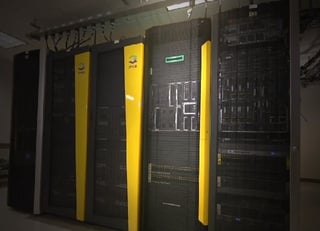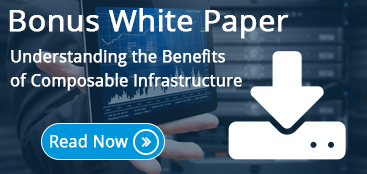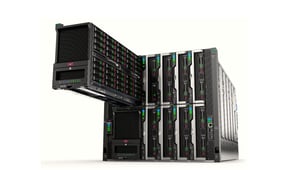 Today’s IT leaders are at a crossroads. Behind them, there’s a long legacy of hardware and software deployment decisions that have served the business well for years. But new business requirements and application development methods have begun to test the status quo, and as they seek to modernize, they will face several difficult decisions. IT leaders can either commit to the cloud, go all in with on-premises infrastructure or evaluate something entirely new.
Today’s IT leaders are at a crossroads. Behind them, there’s a long legacy of hardware and software deployment decisions that have served the business well for years. But new business requirements and application development methods have begun to test the status quo, and as they seek to modernize, they will face several difficult decisions. IT leaders can either commit to the cloud, go all in with on-premises infrastructure or evaluate something entirely new.
One such new approach, composable infrastructure, offers the best of both cloud-based and on-premises infrastructure, while delivering on the promise of flexibility, scalability, and efficiency gains. Composable infrastructure also brings cloud and data center resources together under a common management framework that unleashes the power of the hybrid cloud. For IT leaders, this new technology represents a drastic shift in philosophy and a walk into the great unknown.
Key Considerations When Planning for Composable Infrastructure
With all the benefits and opportunities composable infrastructure offers, IT leaders will likely want to start planning for it soon (If they haven't already!). Before getting started with composable or any data center modernization effort, there are multiple factors to keep in mind. The list below details a few of the most important considerations.
Take responsibility: IT organizations that once focused primarily on asset management must now begin to take on the responsibility for achieving strategic business goals. This means a fundamental shift in IT as a supportive resource to a more collaborative, strategic model. If IT is not actively engaged with business outcomes, the model may fail.
Choose the right platform. Infrastructure options abound, it is important to choose the platform that aligns with your organization’s long-term goals. As it stands, composable infrastructure is the market-ready alternative that promotes the speed and efficiency required by DevOps environments, and products are being developed by any number of major players. But they are all distinct in their approach to implementation, their market readiness, and their applicability to unique business requirements.
Think about the future. Be prepared to take advantage of composable infrastructure by focusing on the coming wave of IT dynamics:
- Continuous IT service delivery
- Infrastructure flexibility
- Workloads that align with business demand (and are not constrained by hardware)
- An increase in IT’s business value
- Automation that provides simplified infrastructure management
- Streamlined deployments that add flexibility to your data center
- Consolidation of Data Centers and simplified infrastructure at branch offices (ROBO)

With multiple vendors each approaching the notion of hybrid IT differently, be extremely focused on looking at standardization measures and standard methodologies and compatibility, and understand how the infrastructure integrates into your current environment. Look for common connectivity protocols and universal APIs, standardized policy adherence and global management tools whenever possible. While composable technology is designed to be vendor agnostic, it will take some time for manufacturers to begin producing modules of compute, fabric and storage that are truly universal.
Let's Take a Look at HPE Synergy
As one of the first vendors to introduce a solution to drive hybrid IT efficiency, HPE Synergy is deemed to be the 'world's first truly composable infrastructure.' HPE Synergy enables you to compose fluid pools of physical and virtual compute, storage, and fabric resources into any configuration for any application—and based on our experience implementing the solution for several of our customers, we've seen the benefits come to fruition. To get to know HPE Synergy better, here are 5 things you needs to know about it:
1. ONE Infrastructure
An infrastructure so intelligent, it can adapt to every workload and deliver services at lightning speed
2. TWO Operating Models
A new category of infrastructure designed to accelerate application delivery in both traditional and new IT environments
3. THREE Design Principles
Fluid resource pools: Single infrastructure of disaggregated resources
Software-defined intelligence: Template-driven workload composition
Unified API: Infrastructure as code
4. FOUR Big Benefits for IT and Business
Reduce cost: Up to 30% reduction in ongoing CAPEX Savings
Deploy at cloud-like speed: Minutes to provision a workload-ready host
Simplify apps: One step to implement updates
Develop more apps: Single line of code to stand up infrastructure
5. FIVE Elements to HPE Synergy
Composer: Composes infrastructure at near instant speeds
Composable frame: All resources needed to run any application
Composable compute: Full portfolio for performance and scalability
Composable storage: High density integrated storage
Composable fabric: Rack scale multi-fabric connectivity
Taking a Closer Look at HPE Synergy
In an episode of Real Tech with WEI, Chief Architect, Dave Fafel, talks about composable infrastructure and introduces the new HPE Synergy. In this quick video Dave discusses:
- Why the modernized data center needs composable infrastructure
- The 5 components of the Synergy platform
- What you really need to know before investing in the solution
If you're interested in learning more about HPE Syenrgy, or simply want to have a discussion around your data center modernization initiatives, let's talk. Contact us today or sign up for a demonstration of HPE Synergy below.












